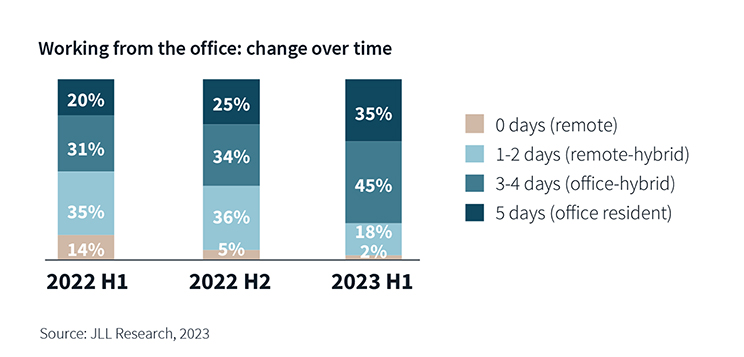Hybrid work continues to grow among global employers. As more companies announce new office attendance mandates, and most workers are back in the office globally, leaders must now consider how to meet new expectations around work and where it’s done.
That’s according to a new report from JLL titled “Is hybrid really working? Creating a dynamic workplace for a productive workforce.” The report explores employers’ and employees’ new expectations in today’s hybrid environment, uncovering best practices to attract employees to the office and maintain the flexibility offered by remote work. The latest report from JLL draws on the global feedback of over 200 corporate real estate (CRE) decision-makers from July to August 2023, as well as a year-long survey of more than 20,000 office workers.
A New Normal for Office Attendance
With the increased emphasis among employers on productivity and operational efficiency, companies continue to adjust their hybrid policies in favor of greater office attendance. Today, employees globally are spending just over three days in the office on average, with peak attendance on Tuesdays, Wednesdays, and Thursdays.

However, despite widespread adoption of hybrid models, variances in office attendance are materializing across regions and countries, ranging from two days in the U.S. and U.K. to over four days on average in China, India, and South Korea. These differences are largely driven by a combination of cultural nuances, living arrangements, and other structural factors.
Overall, the majority of international organizations (87%) are encouraging their employees to work from the office at least some of the time. In fact, only 20% of employees work fully remote or up to two days in the office today, down from 39% a year ago. As employers continue expecting in-office work and companies increasingly pivot away from fully remote hiring, office attendance is expected to incrementally rise through year-end.
Designing the Future Hybrid Workplace Must Balance Collaborative and Focused Work
After three experimental years of hybrid work, employers associate the office with new benefits. Beyond improving collaboration, social connection, and cultural bonds, they see it as a significant contributor to employee productivity—now one of the top three reasons among employers for enticing workers back. Enhanced office technology and improved amenities also continue to play a critical part in attracting employees to work from the office, along with more employers (33%) introducing compulsory attendance.
While most employees are back in the office several days a week, several opportunities are emerging to enhance employee engagement and productivity in a hybrid context. Workers continue to find value in the physical office as a hub for socialization, innovation, and professional growth, but they report that commuting, noise, and lack of privacy are the top barriers to working from the office.
“The office has always been, and will continue to be, central to work experience and culture,” said Neil Murray, CEO of Work Dynamics for JLL. “As more workers return to the office several days a week, we’re continuing to learn about the shifting preferences for ways of working and how we can better deploy technology and flexible arrangements to meet these expectations.
“Ultimately, our research finds that the majority of global workers continue to crave a destination for human connection, so creating dynamic spaces that satisfy a mix of collaborative and focused work needs will ultimately be the most effective strategy to enticing employees to the office on a regular basis.”
As leaders look to strike the balance between managing costs in a challenging economic environment without comprising employee experience, the report said addressing these deterrents will be critical for successful long-term hybrid strategies.
With employees spending half of their time on individual tasks while in the office (51%), the forward-looking companies will be those who are adapting their offices to be not just social hubs, but places that can support the wide range of needs of an office day and that can accommodate the expectations of a diverse workforce. This means adapting workspaces not only to address collective and individual needs, but also to bring together technology and design to improve the balance of collaboration with spaces dedicated to privacy and focused work.
ALSO READ: The State of Facility Maintenance Amid the Return-to-Office Surge
